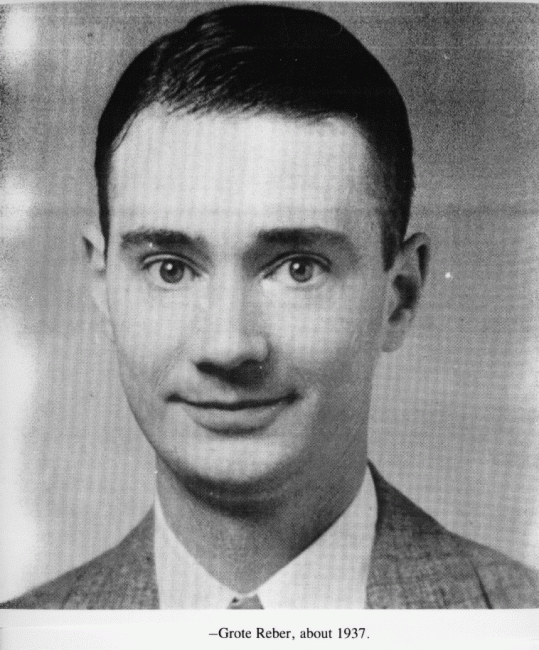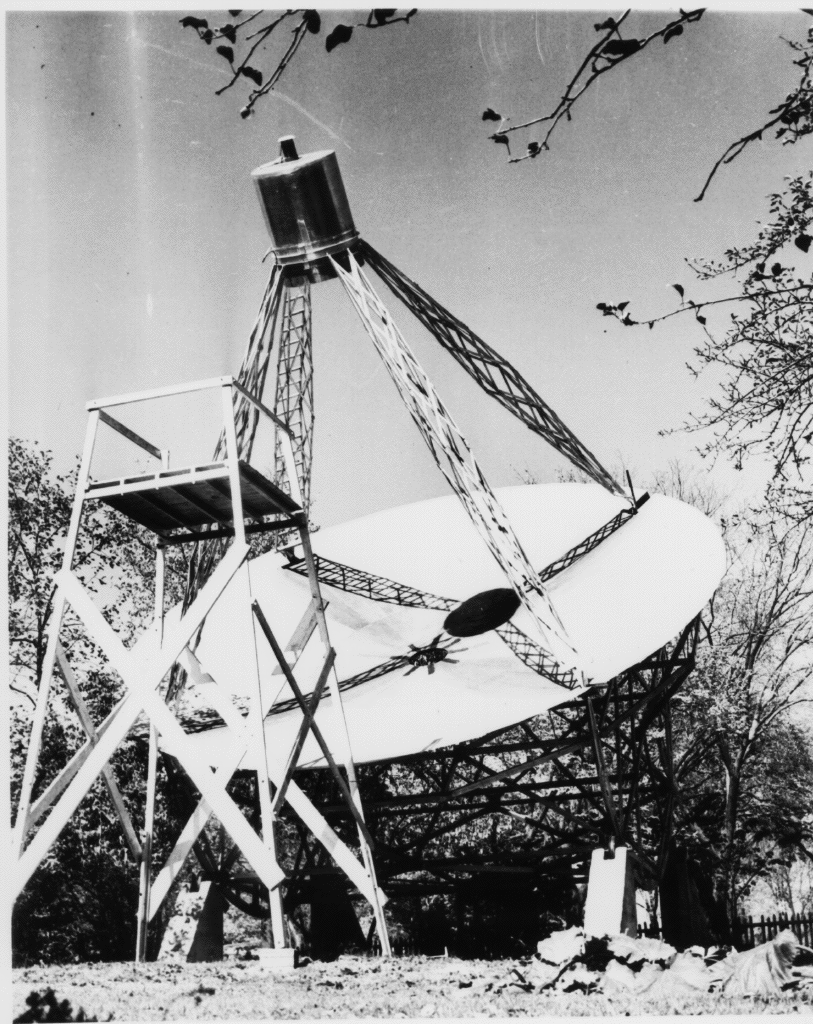On December 22, 1911, American pioneer of radio astronomy Grote Reber was born. He combined his interests in amateur radio and amateur astronomy and became instrumental in investigating and extending Karl Jansky’s [4] pioneering work, who in August 1931 first discovered radio waves emanating from the Milky Way. Reber conducted the first sky survey in the radio frequencies and is considered one of the founding figures of radio astronomy.
Born in Wheaton, Illinois, a suburb of Chicago, Grote Reber graduated BS in 1933 in communications engineering from the Armour Institute of Technology (later Illinois Institute of Technology). As an electrical engineer, Reber was an amateur radio operator, and worked for various radio manufacturers in Chicago from 1933 to 1947.
First Light
Karl Jansky, a physicist and radio engineer at Bell Laboratories, looked into the source of strange radio static at 20.6 MHz during the times of the Depression. He found that it came from the direction of the Sagittarius constellation, but this discovery was not given much attention by astronomers. Reber as a radio amateur learned of Jansky’s “star noise” and decided to do his own research. By using public transportation instead of buying a car, he was able to save money to purchase the parts for his radio telescope.[11] In 1937, Reber decided to build his own radio telescope in his back yard in Wheaton, a suburb of Chicago. His radio telescope consisted of a parabolic sheet metal dish 9 meters in diameter, focusing to a radio receiver 8 meters above the dish. The device was mounted on a tilting stand, allowing it to be pointed in various directions, though not turned. Reber believed that higher frequencies would provide better resolution and that the radio noise likely had a thermal source. Using his expertise as a radio engineer, he studied the radio sky at a frequency that was 160 times higher than the one Jansky used in his research.

Grote Reber (1911 – 2002)
That same year, Fred Whipple,[13] with graduate student Jesse Greenstein, attempted (unsuccessfully by a factor of 100 000) to explain Jansky’s radio flux from the center of our galaxy as hot dust.[11] Unfortunately, Reber’s first two receivers failed to detect any signals from outer space, operating at 3300 MHz and (the second) at 900 MHz. His third, at 160 MHz was successfully tested in 1938. Two years later, Grote Reber made his first professional publication, in the Astrophysical Journal. In this article Reber noted that the intensity of the radio noise was weaker than expected according to the hot dust hypothesis.
Difficulties to Publish the Work
After working at the National Bureau of Standards during World War II, he built a new receiver and conducted a comprehensive survey of the radio sky. From this data, he created a contour map of radio flux. However, he faced difficulty in getting these observations published as many astronomers were skeptical and some even believed the map was a fake. Otto Struve, editor of the Astrophysical Journal, asked astronomers and radio engineers to review Reber’s manuscript containing a contour map of the radio sky, but it was not seen as relevant to either field. Struve then sent astrophysicists Louis Henyey and Philip Keenan to assess Reber’s setup in Wheaton, and they found his research to be credible. His contour map, which was published in the journal in 1944, is similar to modern maps. Reber once commented that if an astronomer wanted a radio, they would simply go to a store and buy one, indicating the disconnect between the fields at the time.[11] During his investigations in 1946, Reber discovered surprisingly intense storms of radio noise from the Sun. He made sensitive observations at 480 MHz and detected the galactic noise, but at a flux lower than at 160 MHz.[11]
Black Body Radiation
During this time he uncovered a mystery that was not explained until the 1950s. The standard theory of radio emissions from space was that they were due to black-body radiation, light (of which radio is a non-visible form) that is given off by all hot bodies. Using this theory one would expect that there would be considerably more high-energy light than low-energy, due to the presence of stars and other hot bodies. However, Reber demonstrated that the reverse was true, and that there was a considerable amount of low-energy radio signal. It was not until the 1950s that synchrotron radiation was offered as an explanation for these.
Later Years
In the early 1950s, Reber received support from the Research Corporation in New York, and moved to Hawaii. Reber turned to the field of medium frequency (hectometre) radio signals in the 0.5—3 MHz range, around the AM broadcast bands. In 1954, Reber moved to Tasmania, the southernmost state of Australia, where he worked with Bill Ellis at the University of Tasmania. In 1962, he was awarded a Honorary Doctor of Science degree from Ohio State University and received the Bruce Medal of the Astronomical Society of the Pacific as well as the Henry Norris Russell Lectureship. In 1963 he was honored with the Elliott Cresson Medal of the Franklin Institute and in 1983 he received the Jackson-Gwilt Medal of the Royal Astronomical Society. Reber’s scientific interests extended beyond astronomy and included experimentation on the handedness of vine growth, published in botanical journals, and research on cosmic rays, published in 1966. He also published work on radio circuitry, ionospheric physics, and the carbon dating of ancient campfire sites.[11]
Reber spent his final days at the Ouse District Hospital, about 50 km northwest of Hobart, Tasmania, where he died in 2002, two days before his 91st birthday.
John D. Kraus (OSU) :: “Grote Reber, Founder of Radio Astronomy“, [9]
References and Further Reading:
- [1] Grote Reber at Harvard
- [2] Grote Reber at SETI
- [3] The Grote Reber Museum
- [4] Karl Jansky and the Discovery of Cosmic Radio Waves, SciHi Blog
- [5] Tyson, J. Anthony (August 2003). “Obituary: Grote Reber”. Physics Today. 56 (8): 63–64.
- [6] Joseph L. Spadley. “The First True Radio Telescope”. Sky and Telescope vol.76:no. 1 (1988) pp. 3, 28–30
- [7] Paul A. Feldman. “Grote Reber: Yesterday and Today”. Sky and Telescope vol.76:no. 1(1988) p. 31
- [8] Grote Reber at Wikidata
- [9] John Kraus (OSU) :: “Grote Reber, Founder of Radio Astronomy“, Workshop: Radio Astronomy and Canada: Fifty Years of Progress Date: Tuesday, December 22, 1987 Location: 100 Sussex Drive, Ottawa, Canada, Canadian Radio Astronomy History @ youtube
- [10] Reber, G. (1982). A Timeless, Boundless, Equilibrium Universe. Proceedings of the Astronomical Society of Australia 4: 482–483.
- [11] Tyson, J. Anthony (August 2003). “Obituary: Grote Reber”. Physics Today. 56 (8): 63–64.
- [12] Herbert Yahraes: Static from the stars: Because a radio ham heard strange sky noises, we may get better FM and television — and learn more about our universe. Popular Science, January 1948, pp. 148–154.
- [13] Fred Whipple and the Dirty Snowballs, SciHi Blog
- [14] Kraus, J. D. Grote Reber – Founder of Radio Astronomy. R.A.S. Canada. Journal V. 82, No. 3/Jun, p. 107, 198pp
- [15] Map of radio telescopes around the world, via Wikidata






